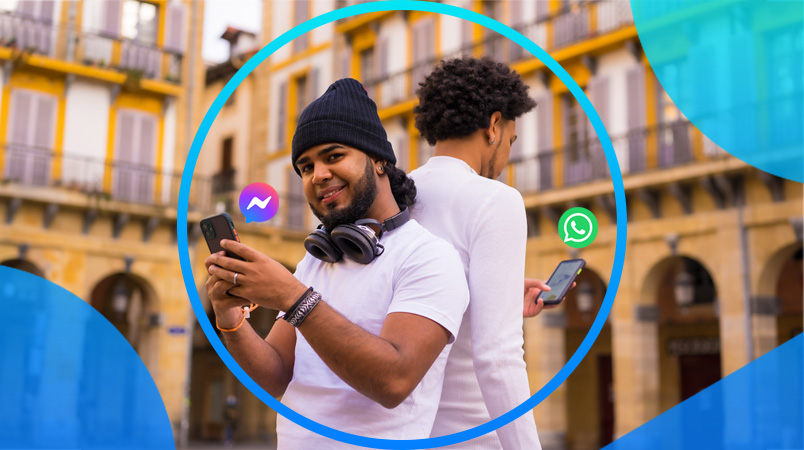I. Why Facebook Messenger for My Business?
As mobile device usage reaches an all-time high, apps like Facebook Messenger make it easier than ever for businesses to connect and engage with more consumers.
Globally, Facebook Messenger draws 1.3 billion users. With more than 2 million monthly downloads, it’s the most popular OTT mobile conversational channel app in the U.S. — over 1/3 of Americans use the platform.
People and businesses exchange over 20 billion messages each month through Facebook Messenger, and that figure is only increasing.
Using Facebook Messenger is a simple way for your business to reach and communicate with customers through a channel most relevant to them.
Facebook Messaging also presents enormous opportunities when helping to support your business objectives:
- Building and gaining brand awareness
- Targeting the right audience with personalized messages
- Generating rapport with existing customers
- Growing your audience and network
- Simplifying and eliminating steps to get in contact with customers
- And, most importantly, helping you drive a higher ROI
II. The Benefits of Facebook Messenger
Facebook Messenger allows you to hone in your customer behavior and reach customers where you know they spend most of their time.
You can use it to:
- Recruit brand advocates
- Support customers
- Advertise
- Sell
- Add a chatbot for time-saving convenience
More businesses are discovering these benefits of using Facebook Messenger for customer support, sales, and marketing:
1. Meet Customers Where They Want to Be
Getting your business active on Messenger allows you to reach your audience where they prefer to spend time — rather than forcing them to leave the platform to communicate.
2. Get Creative With Your Messaging
With Facebook Messenger, you can enhance the messaging experience by using emojis, send voice messages, or experiment with inviting imagery.
3. Save Customer Service Reps Time
People expect prompt responses to their burning questions – and Facebook Messenger helps make that a reality for businesses.
You can set up auto-responses to answer common questions and assist customer service reps or let customers know you aren’t available.
4. Build Brand Trust
One survey found that 69% of U.S. consumers say that being able to message a business directly helps them feel more confident about the brand.
Using Facebook Messenger for Business, customers can quickly get their questions answered and resolve issues with less friction, improving brand perceptions.
5. Grow Your Customer Base
More than a third of Americans use Facebook, and the Messenger ads platform gives you access to a large potential customer base for a low cost.
III. How Does Facebook Messenger Differ From SMS?
The experience of chatting with customers via Facebook Messenger is similar to traditional SMS.
But for businesses, Facebook Messenger poses a few differences:
- Cost: While mobile carriers usually charge businesses a monthly fee to use SMS services, users can chat, make voice calls, and send videos and files with anyone in the world virtually free of charge in Messenger. In other countries where unlimited SMS isn’t standard in mobile plans, using Facebook Messenger can cost significantly less, allowing people to chat at a fraction of SMS’s cost.
- Internet Connection: To chat on Facebook Messenger, users must be connected to Wi-Fi while SMS messages are sent over a cellular network.
- Cross-Platform Capabilities: Businesses can send SMS messages to any mobile phone, regardless of carrier. However, Facebook Messenger only allows you to communicate with other users in the app.
- Device Capabilities: SMS messages can only be sent between mobile phones while OTT mobile chat apps for messaging can be accessed on any Internet-enabled device, including tablets, computers, and phones.
IV. How to Use Facebook Messenger for Business
The use cases for Facebook Messenger are virtually endless. Marketing, customer support, and sales can use Messenger to drive their specific department goals.
Facebook Messenger is a beneficial business tool for companies in all industries, too. The top five most active industries include:
- Professional Services
- Retail
- Local Entertainment
- Public Goods
- Media
Here are some ways companies across industries can use Facebook Messenger to drive their business:
1. Let Users Know They Can Message You
Once you’ve created a Facebook Business page and enabled Messenger, you need to notify users that they can message you.
Adding a Send Message button to your Facebook page is an easy way to accomplish that. From your Business page, you’ll see the option to “Add a button” and click through to select “Messenger.”
To spread the word that you’re available on Messenger, email your existing contacts, and direct them to your Facebook page.
2. Set Up Automatic Replies
85% of consumers expect an answer on Facebook within 6 hours — but you can’t be available 24/7.
Instead, set up auto-replies, so users don’t get radio silence when you’re away. Thank users for reaching out, and set expectations for response times.
If your page manager leaves for an extended period, you can also schedule Away Messages to notify users that no one is available during those times. Away Messages can be customized to include links to FAQ resources, contact information, and more.
3. Enable Click-to-Messenger Ads to Generate New Leads
Facebook has built one of the largest and most advanced ad platforms.
Connecting your Facebook ads with Messenger gives leads direct access to your business and makes it easy to take the next step.
Once leads click through to Messenger, they can ask questions or purchase your products, creating a seamless, personalized experience.
4. Remarket to Leads and Customers
It takes 6 to 8 touchpoints to qualify leads. That means you’ll need to continually market to new leads to nurture them into a qualified, sales-ready opportunity.
Facebook Messenger allows you to serve ads to leads and customers that haven’t taken the next step to remind them of your brand or product.
Retargeting leads and customers is a cost-effective way to increase sales and build awareness.
5. Facilitate Easy Purchases
Messenger also simplifies the purchase process so you can generate more sales from prospects when they’re most engaged with your brand.
Using the Buy Now button, customers can complete transactions within the Messenger app, eliminating potential friction points.
6. Get Customer Service Involved
Customer service plays a pivotal role in shaping brand perceptions. 80% of consumers consider customer experience as crucial as goods or services, and 52% of consumers switched brands because of poor customer service.
Using Messenger for customer service gives users the option to communicate with your business on their terms. No need to wait on hold for hours or keep website chat windows open.
Customers gain direct access to your brand to ask questions or leave feedback. Customer service reps can deliver personalized responses, reconcile purchase issues or even reward customers for constructive feedback to help build brand rapport.
Because the entire chat history stays in Messenger, customers can keep the conversation going when it’s convenient.
7. Initiate New Conversations
Prompting new users to reach out is an effective way to grow your customer base.
Using Facebook ads, you can direct users to Messenger your business to naturally encourage new conversations.
Invite customers to learn about a product or answer a question to start conversations.
8. Promote New Products or Promotions
Have a new product coming out? Need to sell tickets for an event?
Use Messenger to spread the news and get your announcements in front of more people.
9. Automate Frequently Asked Questions
To save your team even more time, set up automatic responses to frequently asked questions, such as store hours, return policies or pricing.
You can also leverage advanced features like custom chatbots to provide advanced functionality. For example, chatbots can share product entails, guide users to take natural next steps, or even gather feedback.
Messenger can always hand off the conversation to a real person to handle more complex inquiries.
You can also include relevant links that direct customers to helpful online content, such as resources, blogs, or landing pages.
V. Best Practices for Businesses Using Facebook Messenger
Looking to get started with Facebook Messenger? Follow these best practices to succeed with this new communication channel:
1. Define User Roles and Responsibilities
Setting up Facebook Messenger for business shouldn’t be taken lightly. Without well-defined roles and responsibilities, customers will likely have a poor experience.
Before launching your Messenger program, answer these questions:
- Who will own your Facebook Messenger strategy and implementation?
- What types of questions will you automate?
- Who is responsible for answering other customer questions?
- How quickly are team members expected to respond?
2. Develop and Enforce Brand Guidelines
The way you communicate via chat matters. Having an uninviting or inconsistent brand experience will quickly turn off a consumer — likely for good.
Facebook is a social platform — so your communication should be friendly yet professional.
However, each employee will have their definition of how to communicate on Facebook. Don’t leave your brand communication up to each person’s discretion.
Before you develop automated communications or send customer service reps to manage your social channels, outline clear guidelines to govern conversations. Include details like:
- Consistent brand and product names
- Warm, welcoming tone (with examples)
- How to be brief
- Conversation closings
- How to de-escalate upset customers
3. Measure and Minimize Response Times
If consumers know they can get a fast response from your business, they’ll favor you over competitors.
Shortening customer wait times will have the biggest impact on brand loyalty and sentiment. But to reduce response times, you need to measure them first.
Fortunately, Facebook Messenger tracks response rates and response times for you.
To earn and maintain the “Very responsive to messages” badge, you must achieve a response rate of 90% and a response time of 15 minutes.
Document and promote these data points with your customer support team, and incentivize employees to hit these metrics.
4. Personalize Your Messaging
Personalization is a powerful marketing tool — 80% of consumers are more likely to purchase from a brand that provides personalized experiences.
To personalize your Facebook Messenger experience, leverage, and refer to users’ context cards. These optional tiles set expectations for communication with your business and offer insights into user behaviors and preferences.
You can also store notes about user preferences or previous conversations for team members to refer to when communicating with that person.
VI. Manage All Your Chat Apps With CM.com
Facebook Messenger provides businesses a cost-effective channel to promote products and services, solve support issues, and even automate answers to common questions to save customer care agents time.
As messaging between companies and consumers expands, customers will expect to reach you across more channels. Juggling multiple chat apps will quickly become inefficient and dampen customer experience.
Whether you’re a global company that aims to accommodate regional communication preferences or just want to offer consumers multiple touchpoints, CM has a solution to help.
Use CM.com’s Mobile Service Cloud platform to unify all of your messaging channels into one dashboard or access our Facebook Messenger for Business API.
Our platform is designed to make the life of your customer care agents easier.
- Available apps include WhatsApp, Apple Messages for Business, Viber, Facebook Messenger, Twitter DM, Telegram, SMS, and RCS.
- A one-stop-shop for your messaging channels, bots, and intuitive customer support software — all from one inbox
- Access all messaging channels and conversations in one view.
Mobile Service Cloud Features:
- Quick Replies: Create custom out-of-office messages, quick replies for FAQs, or a chatbot to help save time.
- Simplified Support: Assign ownership and statuses to agents, and create teams to organize departments, regions, branches, or specialists.
- Customer Profiles: Creates a unique profile for each customer.
- Multiple Channels: Choose from CM.com’s list of available channels and connect the ones you want to use. Easily add new channels as needed.
- Intuitive Dashboard: Get set up and start using the dashboard right away – no development skills required.
- Automatic Channel Fallback: We guarantee the delivery of every message. If there is no internet connection available or your message doesn’t get delivered on your initial channel, an SMS fallback is initiated to ensure the recipient gets your message.
Request a free demo of the Mobile Marketing Cloud, or get started right away!








